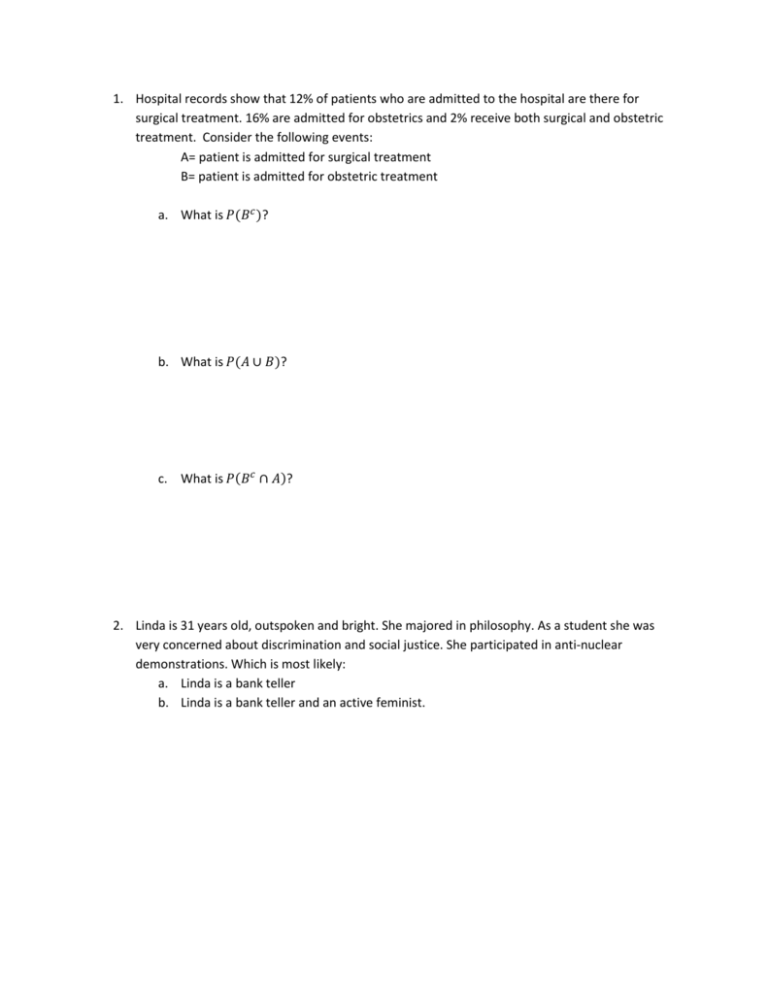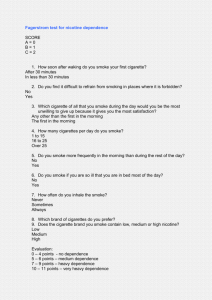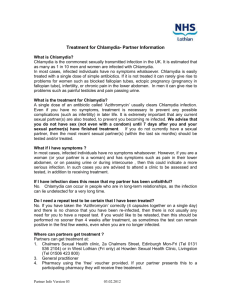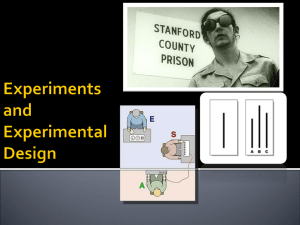Hospital records show that 12% of patients who are admitted to the
advertisement

1. Hospital records show that 12% of patients who are admitted to the hospital are there for surgical treatment. 16% are admitted for obstetrics and 2% receive both surgical and obstetric treatment. Consider the following events: A= patient is admitted for surgical treatment B= patient is admitted for obstetric treatment a. What is 𝑃(𝐵𝑐 )? b. What is 𝑃(𝐴 ∪ 𝐵)? c. What is 𝑃(𝐵𝑐 ∩ 𝐴)? 2. Linda is 31 years old, outspoken and bright. She majored in philosophy. As a student she was very concerned about discrimination and social justice. She participated in anti-nuclear demonstrations. Which is most likely: a. Linda is a bank teller b. Linda is a bank teller and an active feminist. 3. Write out a probability distribution for a fair eight-sided die. X=number rolled. a. What is the probability of getting a number greater than 5? How do you write “probability of getting a number greater than 5” with correct notation? b. What is the probability of getting a number less than or equal to 2? How do you write “probability of getting a number less than or equal to 2” with correct notation? c. If you get 5 dollars every time a 2 is rolled and lose a dollar otherwise, what is your expected winnings after a long time? 4. The table below summarizes the race and positions of 368 NBA players in 1993. Suppose an NBA player is selected at random from that year’s player pool. Guard Forward Center Total White 26 30 28 84 African American 128 122 34 284 Total 154 152 62 368 a. What is the joint distribution of player position and race? b. What is the marginal distribution of race? c. 𝑃(𝑊ℎ𝑖𝑡𝑒) d. 𝑃(𝑊ℎ𝑖𝑡𝑒 ∩ 𝐹𝑜𝑟𝑤𝑎𝑟𝑑 ) e. 𝑃(𝐺𝑢𝑎𝑟𝑑 𝑐 ) f. 𝑃(𝑊ℎ𝑖𝑡𝑒|𝐹𝑜𝑟𝑤𝑎𝑟𝑑) g. 𝑃(𝐹𝑜𝑟𝑤𝑎𝑟𝑑|𝑊ℎ𝑖𝑡𝑒) 5. For two events 𝐴 and 𝐵, 𝑃(𝐴) = .4, 𝑃(𝐵) = .2 and 𝑃(𝐴 ∩ 𝐵) = .08 a. Find 𝑃(𝐴|𝐵) b. Find 𝑃(𝐵|𝐴) c. Are 𝐴 and 𝐵 independent events? d. Are 𝐴 and 𝐵 mutually exclusive (disjoint) events? 6. In a certain population, the probability that a randomly chosen person is a smoker is 25%. The chance that a randomly chosen person develops cancer is 8%. In addition, 5% of people both smoke and develop cancer. a. What is the probability that a randomly chosen person develops cancer supposing that they smoke? b. If a randomly chosen person has cancer what is the probability they smoke? c. Are smoking and cancer independent? d. What is the probability of developing cancer in people who don’t smoke? 7. According to a 2004 CDC study 4% of female college students had Chlamydia. If the chlamydia test has a sensitivity of 99% , P(positive test| Chlamydia)=.99 and a specificity of 80%, P(negative test|no Chlamydia)=.8, what is the chance that a randomly chosen college female who tests positive has chlamydia? a. Draw a venn diagram which represents the situation and answer the question. b. Imagine 100 college females were randomly chosen and take the chlamydia test. Create a table which shows the same information found in the tree and use it to answer the question. c. Draw a tree diagram representing the possible outcomes for the chlamydia test in a population of college females and answer the question. d. What proportion of people will test positive? 8. The TrialNet study identifies the presence of glutamic acid decarboxylase antibodies (GADA), a risk factor for Type 1 diabetes. This test has sensitivity P(positive test | GADA) = 0.76 and specificity P(negative test | no GADA) = 0.99. Epidemiologic studies show that, among individuals who have a relative diagnosed with Type 1 diabetes, 5% have GADA. a. What is the probability of a-positive test? b. What is the probability of a false-positive test (no GADA and positive test)? c. If an individual from this population receives a positive test, what is the probability that he or she actually has GADA? This is the positive predictive value (PPV) of this test. 9. Brett is going to college and he will be randomly assigned a roommate. He is hoping for a roommate who doesn’t smoke and doesn’t snore. Of the male students who like to smoke pot, 60% snore. 75% of the students do not like to smoke pot. 65% of the students do not snore. When Brett finds out that his roommate doesn’t like to smoke pot. What is the probability his roommate doesn’t snore? 10. In a 1998 survey of 9th graders in Minnesota, 22.9% of the boys and 4.5% of the girls admitted that they had gambled at least once a week during the previous year. The population consisted of 50.9% girls and 49.1% boys. Assuming that the survey represented all of Minnesota 9th graders, What is the probability that a randomly selected Minnesota 9th grader is a weekly gambler? 11. In a computer store, 70% of the computers are laptops and 30% are desktops. Five percent of the laptops are on sale and 1% of the desktops are on sale. What percentage of the computers are on sale? 12. According the a 2003 report of the U.S. Health Resources and Services Administration, coinfection of HIV and hepatitis C (HCV) is on the rise. Only about 2% of Americans have HCV, but 25% of Americans with HIV have HCV. Write the information provided in terms of probabilities. Are the two viral infections independent? Explain your reasoning. 13. You roll two fair dice. Write out the probability distribution for the sum of the faces. a. What is the probability that the sum of the faces is less than 4? b. What is the probability that the sum of the faces is less than 12? c. What is the probability that the sum of the faces is at least 3?







